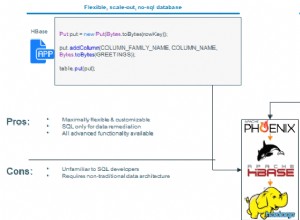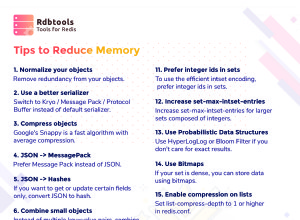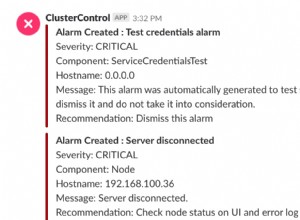यदि आप Stackechange.Redis का उपयोग करते हैं, तो आप इसके API पर सूची विधियों का उपयोग कर सकते हैं। यहाँ वस्तुओं को संग्रहीत करने के लिए एक रेडिस सूची का उपयोग करके IList का एक सरल कार्यान्वयन है।
उम्मीद है कि यह आपको कुछ सूची API विधियों को समझने में मदद कर सकता है:
public class RedisList<T> : IList<T>
{
private static ConnectionMultiplexer _cnn;
private string key;
public RedisList(string key)
{
this.key = key;
_cnn = ConnectionMultiplexer.Connect("localhost");
}
private IDatabase GetRedisDb()
{
return _cnn.GetDatabase();
}
private string Serialize(object obj)
{
return JsonConvert.SerializeObject(obj);
}
private T Deserialize<T>(string serialized)
{
return JsonConvert.DeserializeObject<T>(serialized);
}
public void Insert(int index, T item)
{
var db = GetRedisDb();
var before = db.ListGetByIndex(key, index);
db.ListInsertBefore(key, before, Serialize(item));
}
public void RemoveAt(int index)
{
var db = GetRedisDb();
var value = db.ListGetByIndex(key, index);
if (!value.IsNull)
{
db.ListRemove(key, value);
}
}
public T this[int index]
{
get
{
var value = GetRedisDb().ListGetByIndex(key, index);
return Deserialize<T>(value.ToString());
}
set
{
Insert(index, value);
}
}
public void Add(T item)
{
GetRedisDb().ListRightPush(key, Serialize(item));
}
public void Clear()
{
GetRedisDb().KeyDelete(key);
}
public bool Contains(T item)
{
for (int i = 0; i < Count; i++)
{
if (GetRedisDb().ListGetByIndex(key, i).ToString().Equals(Serialize(item)))
{
return true;
}
}
return false;
}
public void CopyTo(T[] array, int arrayIndex)
{
GetRedisDb().ListRange(key).CopyTo(array, arrayIndex);
}
public int IndexOf(T item)
{
for (int i = 0; i < Count; i++)
{
if (GetRedisDb().ListGetByIndex(key, i).ToString().Equals(Serialize(item)))
{
return i;
}
}
return -1;
}
public int Count
{
get { return (int)GetRedisDb().ListLength(key); }
}
public bool IsReadOnly
{
get { return false; }
}
public bool Remove(T item)
{
return GetRedisDb().ListRemove(key, Serialize(item)) > 0;
}
public IEnumerator<T> GetEnumerator()
{
for (int i = 0; i < this.Count; i++)
{
yield return Deserialize<T>(GetRedisDb().ListGetByIndex(key, i).ToString());
}
}
System.Collections.IEnumerator System.Collections.IEnumerable.GetEnumerator()
{
for (int i = 0; i < this.Count; i++)
{
yield return Deserialize<T>(GetRedisDb().ListGetByIndex(key, i).ToString());
}
}
}
क्रमांकन के लिए Newtonsoft.Json के उपयोग पर ध्यान दें। आपको निम्नलिखित nu-get संकुल की आवश्यकता होगी:
Install-Package Newtonsoft.Json
Install-Package StackExchange.Redis
आपके प्रश्न और टिप्पणियों को पढ़ने के बाद, चूंकि आप कुंजी द्वारा तत्वों तक पहुंच बनाना चाहते हैं, मुझे लगता है कि आप रेडिस हैश की तलाश कर रहे हैं, जो मूल्यों से जुड़े क्षेत्रों से बने मानचित्र हैं।
तो आपके पास हैश के लिए रेडिस कुंजी हो सकती है जिसमें आपके सभी ग्राहक शामिल हैं, प्रत्येक एक फ़ील्ड से जुड़ा मान है। आप CustomerId को फ़ील्ड के रूप में चुन सकते हैं, ताकि आप O(1) में उसकी आईडी से ग्राहक प्राप्त कर सकें।
मुझे लगता है कि IDictionary को लागू करना इसे काम करते देखने का एक अच्छा तरीका है।
public class RedisDictionary<TKey, TValue> : IDictionary<TKey, TValue>
{
private static ConnectionMultiplexer _cnn;
private string _redisKey;
public RedisDictionary(string redisKey)
{
_redisKey = redisKey;
_cnn = ConnectionMultiplexer.Connect("localhost");
}
private IDatabase GetRedisDb()
{
return _cnn.GetDatabase();
}
private string Serialize(object obj)
{
return JsonConvert.SerializeObject(obj);
}
private T Deserialize<T>(string serialized)
{
return JsonConvert.DeserializeObject<T>(serialized);
}
public void Add(TKey key, TValue value)
{
GetRedisDb().HashSet(_redisKey, Serialize(key), Serialize(value));
}
public bool ContainsKey(TKey key)
{
return GetRedisDb().HashExists(_redisKey, Serialize(key));
}
public bool Remove(TKey key)
{
return GetRedisDb().HashDelete(_redisKey, Serialize(key));
}
public bool TryGetValue(TKey key, out TValue value)
{
var redisValue = GetRedisDb().HashGet(_redisKey, Serialize(key));
if (redisValue.IsNull)
{
value = default(TValue);
return false;
}
value = Deserialize<TValue>(redisValue.ToString());
return true;
}
public ICollection<TValue> Values
{
get { return new Collection<TValue>(GetRedisDb().HashValues(_redisKey).Select(h => Deserialize<TValue>(h.ToString())).ToList()); }
}
public ICollection<TKey> Keys
{
get { return new Collection<TKey>(GetRedisDb().HashKeys(_redisKey).Select(h => Deserialize<TKey>(h.ToString())).ToList()); }
}
public TValue this[TKey key]
{
get
{
var redisValue = GetRedisDb().HashGet(_redisKey, Serialize(key));
return redisValue.IsNull ? default(TValue) : Deserialize<TValue>(redisValue.ToString());
}
set
{
Add(key, value);
}
}
public void Add(KeyValuePair<TKey, TValue> item)
{
Add(item.Key, item.Value);
}
public void Clear()
{
GetRedisDb().KeyDelete(_redisKey);
}
public bool Contains(KeyValuePair<TKey, TValue> item)
{
return GetRedisDb().HashExists(_redisKey, Serialize(item.Key));
}
public void CopyTo(KeyValuePair<TKey, TValue>[] array, int arrayIndex)
{
GetRedisDb().HashGetAll(_redisKey).CopyTo(array, arrayIndex);
}
public int Count
{
get { return (int)GetRedisDb().HashLength(_redisKey); }
}
public bool IsReadOnly
{
get { return false; }
}
public bool Remove(KeyValuePair<TKey, TValue> item)
{
return Remove(item.Key);
}
public IEnumerator<KeyValuePair<TKey, TValue>> GetEnumerator()
{
var db = GetRedisDb();
foreach (var hashKey in db.HashKeys(_redisKey))
{
var redisValue = db.HashGet(_redisKey, hashKey);
yield return new KeyValuePair<TKey, TValue>(Deserialize<TKey>(hashKey.ToString()), Deserialize<TValue>(redisValue.ToString()));
}
}
System.Collections.IEnumerator System.Collections.IEnumerable.GetEnumerator()
{
yield return GetEnumerator();
}
public void AddMultiple(IEnumerable<KeyValuePair<TKey, TValue>> items)
{
GetRedisDb()
.HashSet(_redisKey, items.Select(i => new HashEntry(Serialize(i.Key), Serialize(i.Value))).ToArray());
}
}
और इसका उपयोग करने के लिए यहां कुछ उदाहरण दिए गए हैं:
// Insert customers to the cache
var customers = new RedisDictionary<int, Customer>("customers");
customers.Add(100, new Customer() { Id = 100, Name = "John" });
customers.Add(200, new Customer() { Id = 200, Name = "Peter" });
// Or if you have a list of customers retrieved from DB:
IList<Customer> customerListFromDb;
customers.AddMultiple(customerListFromDb.ToDictionary(k => k.Id));
// Query a customer by its id
var customers = new RedisDictionary<int, Customer>("customers");
Customer customer100 = customers[100];
अपडेट करें (अक्टूबर 2015)
इन संग्रहों का बेहतर कार्यान्वयन CachingFramework.Redis पुस्तकालय पर पाया जा सकता है।
यह रहा कोड।




